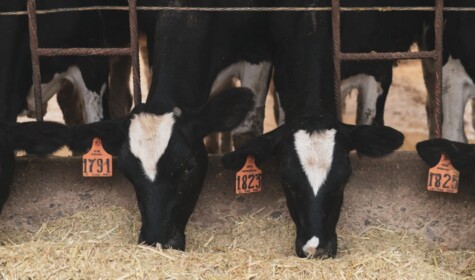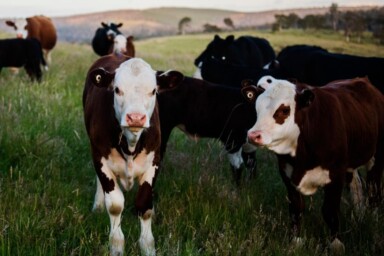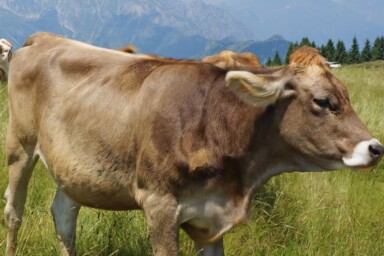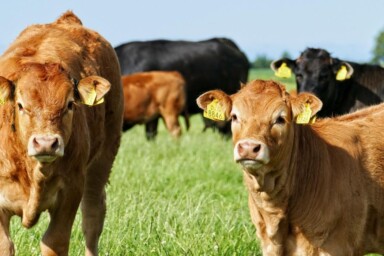The use of methane inhibitors in cattle and sheep feed was the subject of a recent consultation by the UK and devolved governments, to which the SFT responded. Reducing methane emissions is essential, but we have concerns about some of the products under consideration, as well as the wider impacts for animal welfare, biodiversity, the environment and both human and animal health that could arise. We provide some background, then set out our perspective on each issue.
With greenhouse gas emissions continuing to rise, and climate change already increasing the severity and duration of extreme weather, meaningful action to phase out the use of fossil fuels is urgently needed.
Yet, despite the important progress on a Loss and Damage Fund at COP 27, aspirations of staying within 1.5°C of warming took a knock when a last minute change to the final text exempted natural gas from a commitment to phase out all fossil fuels. It was a watering down of ambition the planet can ill afford – according to the latest UNEP Emissions Gap Report, which monitors the difference between reality and targets, we are on track for 2.8°C of warming by the end of the century, a prediction up from 2.7°C last year.
While we need to reduce the emissions of all three major greenhouse gases, getting CO2 levels down to net zero by 2050 at the latest, is the most urgent task we face, even though many politicians and business leaders have yet to embrace this. This is because CO2 is an extremely long-lived gas, so once it enters the atmosphere, most of it stays there for thousands of years. Ongoing emissions of CO2 therefore accumulate in the atmosphere, causing a continuous rise in temperatures.
Methane
Methane on the other hand, behaves very differently from CO2, with most of it breaking down within 10-12 years. In total, it is estimated that methane has been responsible for around a third of the 1.1°C of warming experienced to date, but because of its short life in the atmosphere, its contribution to global warming today is largely based on the amount we have emitted over the last decade or so (an amount that continues to increase). What this means is that reducing methane emissions globally could have a small but beneficial cooling effect within 10-20 years which would help to offset the expected increase in warming due to CO2. The UNEP estimates that if we achieve a 45% reduction in global methane emissions by 2045, this could reduce global warming by 0.3°C. This would help us stay within the target of 1.5°C of warming by 2050.
Scientists at Oxford University acknowledge that taking action on methane now rather than later could bring benefits, but using more precise methods they conclude that this would be, “by a much smaller amount than the direct GWP100 equivalence between methane and CO2 [the method used by the UNEP] would suggest. GWP100, the traditional method of calculating the warming contribution of greenhouse gases, does not provide an accurate picture for methane, as is explained in the second half of this video by Professor Myles Allen.
Nevertheless, reducing methane emissions is still very important and with growing concern that the world is a long way off track for meeting its CO2 reduction targets agreed in Paris, attention has increasingly focused on methane in recent years. The UK Government was one of the first signatories of the Global Methane Pledge which commits the government, with other countries, “to collectively reduce global methane emissions by at least 30% by 2030”.
Methane inhibitors
UK agriculture is responsible for 10% of the UK’s home-produced greenhouse gas emissions and about 54% of that is related to ruminant methane (when measured using the GWP100 metric). One potential solution to help reduce this that has received a lot of attention recently, is the use of methane suppressing feed additives – substances which when mixed with feed, reduce the amount of methane cattle and sheep produce in their rumen and then emit into the atmosphere.
However, while there is a clear need to tackle anthropogenic methane emissions – including from ruminant livestock in the UK – and we agree that some additives potentially have a valuable role to play in achieving this, we, nevertheless, have some significant concerns.
Human and animal health concerns
We already know that some products proposed as methane suppressing additives can have negative impacts on animal health and welfare – for instance, the antibiotic growth promoter monensin, widely used in US cattle feedlots, and nitrate salts that can cause severe illness or even death in cattle when administered incorrectly. Then, there are other additives for which potential health risks have been proposed. For instance, the red seaweed Asparagopsis produces the probably carcinogenic compound bromoform, accidental ingestion of which has caused a range of health problems, though more research is required to consider the implications of this.
Even where more rigorous testing has been carried out, as is the case with the chemical 3-NOP, which has recently been approved in the EU, there are still risks. 3-NOP poses a health risk to those producing it, and potentially to those adding it to feed rations too. It can cause irritation to the skin and eyes, while inhalation could also be dangerous. We should also keep in mind that its use will bring about a change to a key aspect of ruminant metabolism. All available evidence indicates this is safe, but the last time we did something similarly unnatural in the UK, by adding meat and bone meal to cattle feed, it was also said to be totally safe. The negative aspect of the practice, the emergence and spread of Bovine Spongiform Encepalopathy (BSE) or Mad Cow Disease, as it was dubbed, wasn’t identified for over half a century and it took well over a further decade before it was clear this was the cause of a new and fatal variant of Creutzfeldt-Jakob Disease (CJD), in humans.
There is also a long list of synthetic pesticides and antimicrobials which were once thought to be totally safe, but which have eventually been found to cause harm decades after they were first introduced. Pesticides like the organochlorines, paraquat and the neonicotinoids, and antimicrobials like avoparcin, virginiamycin, carbadox, chloramphenicol and colistin have all now been banned or, in one case, severely restricted. The hope, of course, is that this won’t be the case with feed additives, but with the testing and roll-out of these products still in its infancy, caution is needed.
Indirect effects for human health
There are also concerns around the indirect impacts some feed additives might have on human health and on animal health and welfare. For instance, we now know that monensin has been shown to have potential for treating both pancreatic cancer and new viral infections, while one component of it, monensin A has the potential to be developed as an antibiotic of last resort, for treating infections caused by certain hospital superbugs. A more general health and welfare risk is that, at present, feed additives can only be used in intensive production systems, as they need to be mixed with the animal’s feed. Efforts to incentivize the use of feed additives could, therefore, entrench, or even support the expansion of intensive housed systems. These tend to be associated with lower levels of animal welfare and contentment and at a global level, higher levels of zoonotic infections, such as E.coli 0157, campylobacter and salmonella.
Potential environmental impacts
Further intensification of the ruminant sector due to the promotion of feed additives could have negative impacts on the environment, too. The air and water pollution problems associated with keeping very large numbers of cattle together are well-known, as was highlighted in depressing detail in a recent Guardian exposé. But there is also a risk that feed additives could kill off the emerging interest in regenerative agriculture, where grazing animals play an important role. Intensification could also cause further biodiversity loss and CO2 emissions, by bringing about an even bigger transition from extensive, grass-based systems to year-round confinement, with diets based more on grain and soya and less on grass. Intensive production systems can be associated with lower methane emissions, but they have higher CO2 and N2O emissions due to greater energy and fertiliser use, and the long-term soil degradation associated with both grain and soya production.
Methane suppressing feed additives cannot currently be used in extensive grazing systems. So, if their use were to be required for, say, receipt of public money, or an assurance scheme, there could also be a real risk that extensive grazing systems would become even more economically disadvantaged than they are at present. This could then lead to the closure of grazing livestock farms. These are not all perfect from a biodiversity perspective, but they are still of huge importance as grazed habitats for a wide variety of plant and animal species.
Slow-release boluses, mineral licks and the like may eventually present a means of delivering additives in grazing systems, with 3-NOP and monensin being two candidates for this. However, there has been very little research into whether this would work safely and effectively in practice.
The environmental impacts of feed additive production also need to be considered. This is particularly relevant to additives such as the tropical red seaweed Asparagopsis, which has shown promising potential. At present, it is only grown on a very small scale, so what might happen if it were to be grown in commercial quantities over a much wider area? Large-scale seaweed production could be harmful to the environment: the spread of non-native invasive species and pests and diseases, wildlife becoming entangled in production infrastructure and noise pollution are all potential issues that have been highlighted. But it could also deliver major benefits, including a reduction in excess nitrogen in the marine environment, protection from coastal erosion and significant amounts of carbon sequestration.
Basically, we don’t know what the large-scale production of such seaweed species would mean for the environment, or whether it would even be possible. And this lack of evidence is a major issue for feed additives and their efficacy more generally. A few additives have consistently been shown to deliver significant emission reductions, but there are many others where the evidence is minimal at best. For some additives, it is also not clear whether they will continue to be effective over the long-term. There is evidence that the efficacy of monensin, saponins, direct-fed microbials and, most notably, 3-NOP (when added to high-forage diets) may decline over time, as the rumen microbiome can adjust and produce methane in other ways.
None of this is to say we should dismiss their potential out of hand. If, for example, it proves possible to produce seaweed at scale sustainably, and process it into a safe product, that could be of significant benefit.
Potentially better alternatives
It is important to add that there are other potential means of reducing methane emissions from ruminants which are not feed additives. Perhaps the most promising of these is the selective breeding of animals for low methane production, an area of research which in the UK is being led by Scotland’s Rural College (SRUC). In a recent study, they found that by selecting animals according to 30 rumen microbial genes associated with low methane production, emissions can be reduced by 17% of the mean per generation. Their findings also suggest that this mitigation potential should be achievable across any breed or production system. More work is required to make the genetic testing scalable and affordable.
There is also research from the UK showing that a 10% reduction in cow size could reduce emissions by around 8% with no negatives for productivity, profitability or environmental sustainability. Improvements in herd health (by tackling diseases like BVD, Johnes’ and mastitis) could reduce total GHG emissions by approximately 10%, due to the positive impact this would have on productivity. In addition, there is ongoing work into the development of a vaccine which could reduce methane emissions. Field studies have so far been unsuccessful, but laboratory results have shown this to be a promising avenue for future research. Finally, there is also some evidence that grazing ruminants on tannin-containing legumes (e.g. birdsfoot trefoil) and some herbs, especially plantain, can deliver reductions in methane emissions, whilst providing other benefits, such as major reductions in nitrogen losses, which represent a significant source of pollution and greenhouse gas emissions.
Putting things in context
Most importantly, the drive to reduce ruminant methane emissions, while important must not become all-consuming. Grazed ruminants provide many benefits when managed well, and the delivery of these must not be jeopardised by a push to cut UK emissions of methane without considering the wider implications.
One of these is the potential harm which a further reduction in UK ruminant numbers could have on our overall climate footprint, if we end up importing more beef or lamb. We already import 20% of our beef, some of it from countries such as Australia and Brazil where deforestation is continuing, most of it to create additional grazing land or to grow yet more soya. As analysis by the Climate Change Committee has shown, importing more beef from areas with a global-average beef carbon footprint would result in a net increase in warming, even if we were to reduce personal consumption in the UK by 20%.
It is also vital to remember that sheep and cattle are far from the only source of methane. Ruminants, waste and rice production combined, produce more methane than the fossil fuel industries. However, at 111 million tonnes per year, global ruminant emissions on their own are similar to and slightly lower than the 128 million tonnes lost by the fossil fuel industry, as shown in the Global Methane Budget, 2008-2017 (See Table 3, p. 1580).
It’s also become clear that fossil fuel emissions have been grossly underreported. New high-precision methods for monitoring methane losses from oil, gas and coal extraction and use are finding some of them to be two or even three times higher than the figures reported to regulators by these industries. A report from CarbonBrief estimates that globally, methane losses from fossil fuel extraction and use are 20-40% higher than official figures indicate. The good news is that well-tested technological solutions exist to stop these losses and they are already being introduced by some companies.
This doesn’t mean we should not seek to reduce methane emissions from livestock, but it does show that our priorities and the relentless media focus on cattle emissions may be misguided, especially since fossil fuels are also the primary source of CO2 emissions.
Even with the urgent need to address global warming, we must not allow vested interests from the fossil fuel industries to stampede us into making decisions we will later regret. In this context, we need to note the conclusions from climate scientists at Oxford University. They tell us, “Reducing methane emissions to zero while continuing to emit CO2 could delay, but not prevent, global temperatures rising.”







